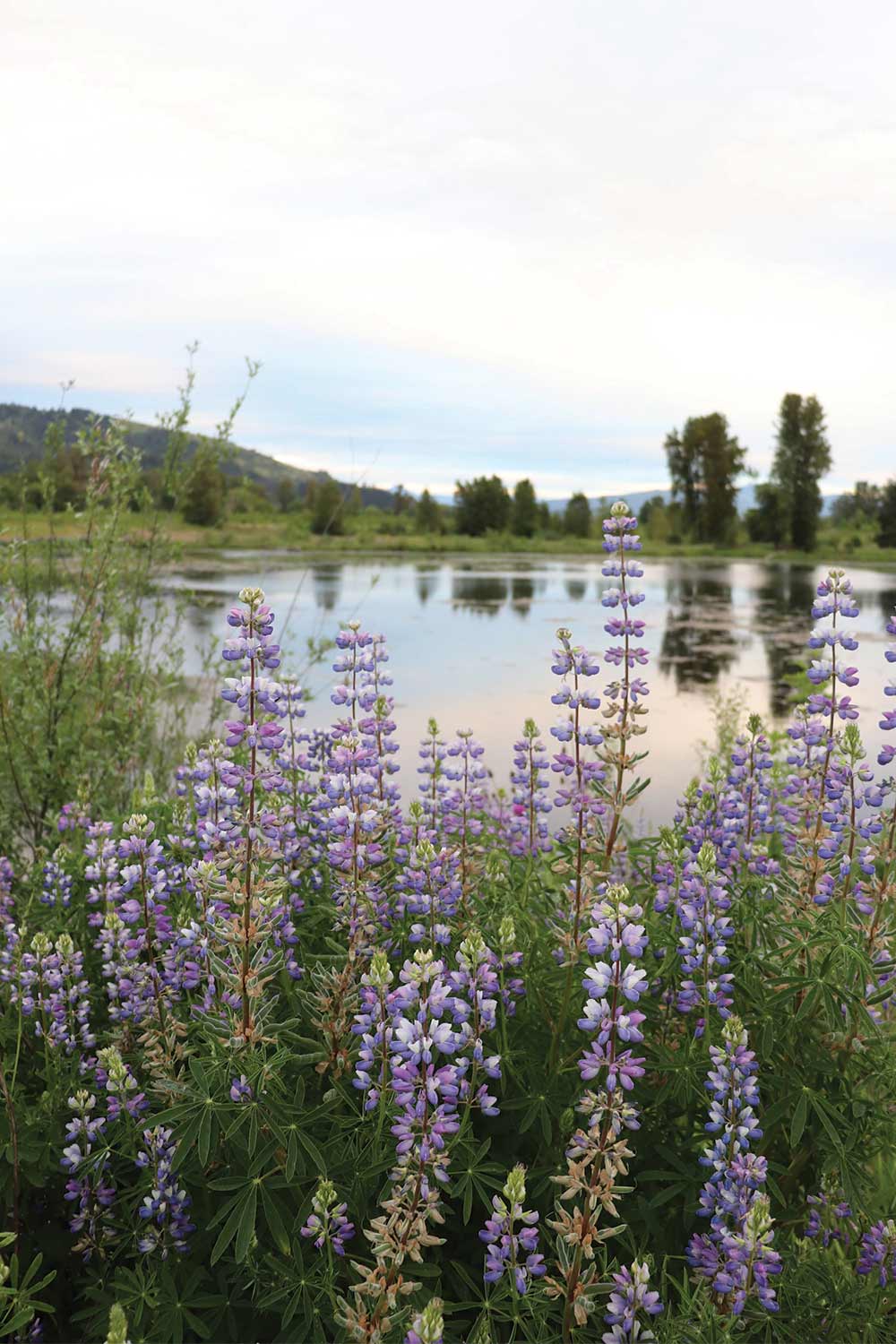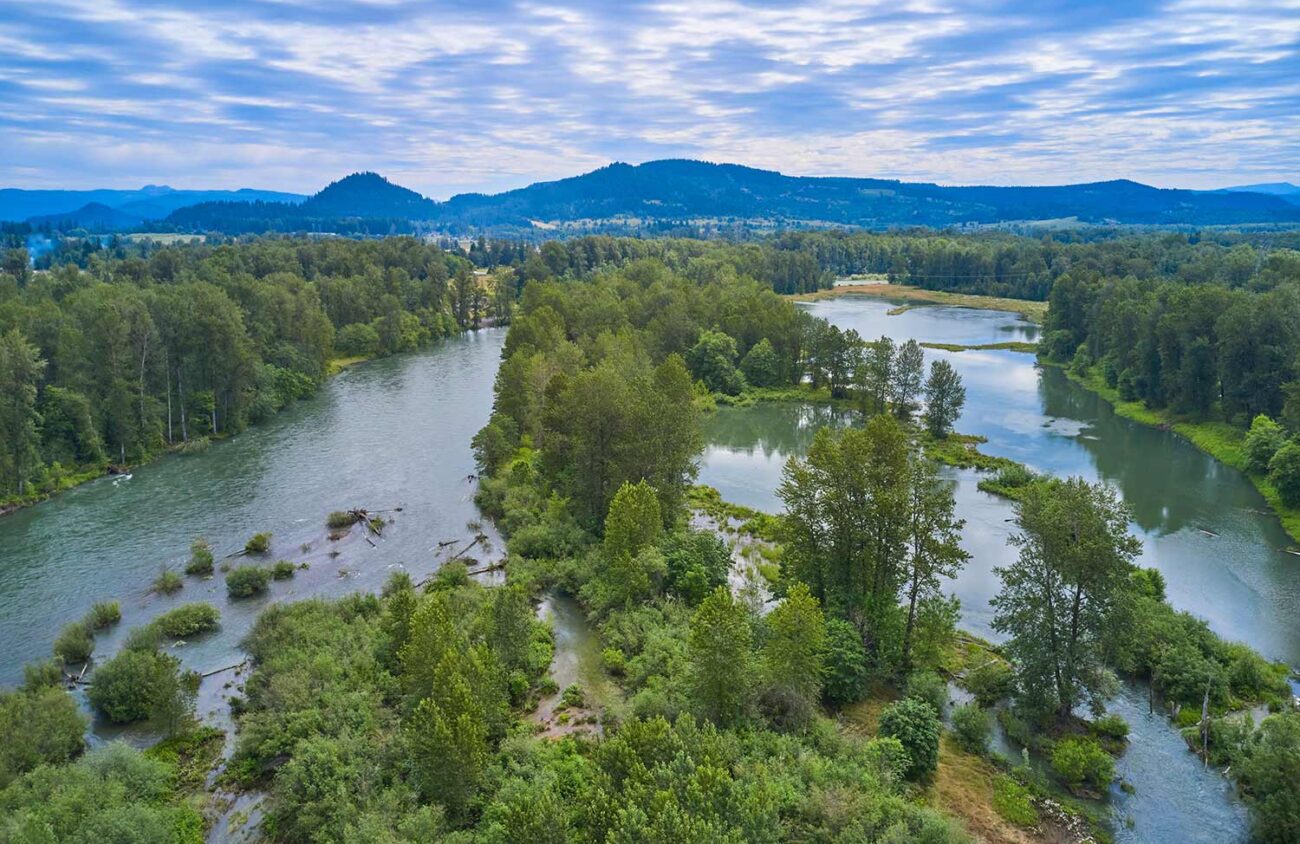“How can we restrain ourselves from loving places to death?” asks Joe Moll, executive director of the McKenzie River Trust. “How can you have a big natural area, really close to town, that becomes accessible over time, but with limitations?”
Moll is speaking of the Willamette Confluence Preserve, a 1,305-acre property at the base of Mount Pisgah, close to the Mount Pisgah Arboretum, which is part of Howard Buford Recreation Area, where the Coast and Middle forks of the Willamette River come together. The property, used as a gravel extraction site for decades, had been carefully restored by The Nature Conservancy over the past 12 years before its recent transfer to the McKenzie River Trust. “Their goal was to do habitat restoration and then look for a long-term steward,” Moll says.
Jason Nuckols, estuaries and freshwater project manager for TNC, calls the Willamette Confluence Preserve the long awaited “missing piece,” and for good reason. The land was coveted for years by environmental interest groups because of its central location, size and how its recovery would benefit the local ecosystem. More than a decade later, what was once bare rock and blackberries is unrecognizable, thriving with native plants and wildlife. Now a key question remains. Can a balance be struck between environmental preservation and controlled public access?
Mull explains that the trust, along with its partners, will spend the next 18 months making crucial decisions about the future of the preserve. For example, they will address the kind of limited guided access that will be permitted. Moll emphasizes the importance of collective care and working closely with regional tribes and Indigenous people.
However, the land acquisition came with conditions. “This land has been designated for fish and wildlife, that’s the primary goal,” he says. “Unfettered access can disturb wildlife, interfere with their breeding habits. It could trample native plants, bring in weed seeds.”
In 2010, when The Nature Conservancy bought the property from a local gravel company for $23 million, the organization had a tough job ahead. “It used to be bare rock, very compacted because it had been driven on by heavy machinery for decades and decades,” Nuckols says. “If there was anything growing, it was mostly blackberry and scotch broom, which are invasive species.” The 20 ponds on the site were gravel extraction pits filled with rainwater. There were overgrown woodlands and neglected fields with dikes narrowing the river.
Nuckols says there weren’t many models for such a large-scale restoration. “We did a lot of research, looking all over the world,” he says. “Went down to the Russian River in California where they had been doing a lot of restoration on aggregate mining sites.” To assure success, the TNC restoration team, including scientists, volunteers and ecological restoration experts, took their time. “We wanted to go at a pace where we could apply lessons learned,” Nuckols says.
Wildish Sand and Gravel Company, which owned the property up until 2010, had been mining in the river until the Clean Water Act was passed in the early 1970s, Nuckols explains. Unable to continue to mine in the river, the company manipulated its flow, installing dikes that disrupted the river’s natural flood plains and width, changing its ecosystem over time.
“They took the wild, meandering natural floodplain and started to harden it by putting it into a narrow, straight channel and not allowing the river to move where it wanted to,” Nuckols says. “So the entire five-plus miles of the Middle Fork were shut off from the river processes.” He says TNC sought to remove those barriers, reconnecting the floodplain and allowing the river to return to its natural state.
Nuckols says the reconnection allowed the water to slow down and spread out, which helped with flood attenuation and native fish and wildlife habitat. “A big driver here was that our juvenile Chinook species use this area when they’re out migrating from upriver,” Nuckols says. “It’s critical for juveniles to get out of that fast-moving river and onto that floodplain to access food and preserve resources.” Chinook are a keystone species, so in helping the salmon, the entire ecosystem benefits, Nuckols says.
When TNC acquired the property, the ponds were far from an ideal habitat for native species. “These were very warm water stagnant ponds that held a lot of invasive warm-water fish like bass, carp and sunfish,” Nuckols says. Now 16 out of the 20 ponds are backwater areas connected to the river.
“By reconnecting to the river, restoring the hydrology and improving water quality, the populations of non-native fish have died down,” Nuckols says. Though he admits that it’s impossible to eliminate these species entirely, it’s possible to find ways for native fish to thrive. “If you can create cold-water habitat, hiding places, emergent vegetation, then you can not only attract native fish but have places where the native and non-native fish can coexist,” he says.
“A few ponds were too far away from the river for it to make sense ecologically and financially to reconnect them,” Nuckols says. They were restored as habitat for Western pond turtles, red legged frogs, nesting birds and waterfowl. “What we wanted to do was not only shape the banks, but slope them back for wildlife and fish,” he says.
After contouring and reconnection, TNC revegetated all those ponds. “We planted around 500,000 trees and shrubs. Some of them are in their seventh, eighth year of growth.” Nuckols says the trees have made the landscape unrecognizable. “Alders and cottonwoods and willows have grown 15 to 20 feet tall from what used to be bare rock.” Nuckols says that he loves to take people to the property who saw the site before the work was done. “They often don’t know where they are,” he laughs.
Enlarge

Nuckols says they also planted dozens of herbaceous plant species: “Flowers, emergent plants, aquatic plants, reeds and brushes.” The open fields around the ponds were restored to a prairie landscape, he says. “We restored the woodlands by removing or thinning trees, and mowing.”
Large trunks and branches from the forest restoration were transported to the floodplain, creating critical habitat and a base for the food chain, he says. “It was a full circle moment, increasing the health of the forest and decreasing our fire vulnerability.”
It’s been encouraging for Nuckols to see the multiple families of river otters on site. “Otters,” he says, “are an indicator of the function and health of a system.”
As for the future of the Willamette Confluence Preserve, volunteer John Helmer has some ideas. Helmer has been involved in the restoration process since its inception. In recent years, he’s witnessed the preserve’s potential as the ideal location for groups who normally don’t have easy access to nature. He does limited mobility tours, serving elderly folks but also young people with physical limitations. “We hope this year to have some off-road wheelchairs available,” Helmer says.
He also leads an event called Nature Your Way, which brings people to the property, letting them enjoy the wilderness however they like — whether that be reading under a tree, creating art or identifying plants and scat.
Helmer’s vision has only expanded its reach, and he is in talks with a Latino/a leadership academy to schedule a visit. “We also have tours planned for adults with learning disabilities and an event with a wheelchair recreation group,” he says.
The closed nature of the preserve makes it perfect for groups who might be physically identifiable and feel less welcome in public natural areas, Helmer explains.
MRT is also invested in the preserve as a site for hands-on environmental education. The trust has partnered with Springfield School District WELL (Water and Energy Learning Lab) Project, which provides students with the chance to learn about energy and water sciences.
Limiting public access to nature may seem unfamiliar, but balance is key when it comes to what’s best for the preserve and wildlife that lives there, Moll says.
Nuckols says he feels confident about the preserve’s future. “We set the land on a trajectory of healing,” he says. “With time, it will take care of itself.”
Find out more about the Willamette Confluence Preserve and Mckenzie River Trust’s vision at MckenzieRiver.org or call 541-345-2799. MRT is located at 120 Shelton McMurphey Blvd. Ste. 270 in Eugene, and go to Howard Buford Recreation Area and the Mt. Pisgah Arboretum to check out the area near the restoration at 34901 Frank Parrish Rd., Eugene.
